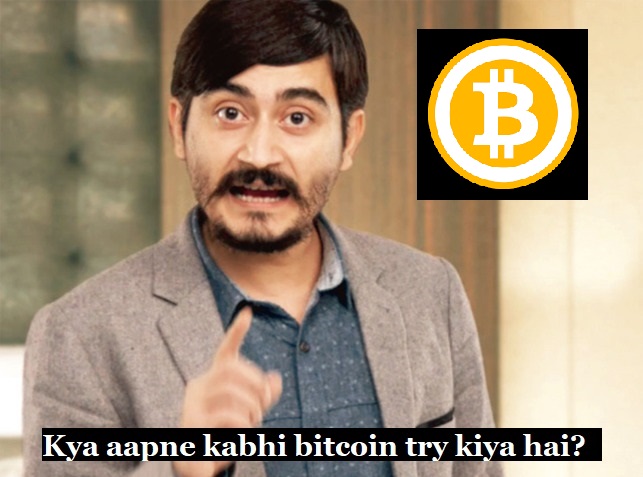By now, we are Rap Gods when it comes to saying “Mutual Fund investments are subject to market risk. Please read the offer document carefully before investing”. Yes, we all are pretty much aware of how “Mutual Funds sahi hai” and thus, where and how to invest so as to get maximum returns. We gain our 4-5% on equities yearly, get tax benefits on it, and so it seems like a Utopian financial world.
You really think you’re doing justice to your money though? Honestly, the only time you should be happy with the figure of “4-5%” is when it represents the % of fat in your body. Not the money added to your bank! Think large, make your life larger! “How?” you ask?

That’s right. Bitcoin - The most interesting B-word since Virat Kohli. Most of the world is interested in knowing what it is and what it means, because the few who do, are reaping heart-warming profits (we’re still talking about Bitcoin!). That the world is fast on its way to becoming one single, digital economy is no mythological folktale. It’s the reality, and it’s happening fast. We as a country though, are still warming up to the idea of e-wallets like Paytm and are still skeptic about having money that we can’t physically put in our pockets. Which is why the surge of Bitcoin in Western countries like USA and UK has largely been bereft of our association with it. As a country with 1/7th of the world’s population though, it seems such a waste, doesn’t it? It’s time we Indians shed our ancient adulation of physical cash and opened our minds to the latest buzz of the finance world - Cryptocurrency.
What is Cryptocurrency?
As simply put by Investopedia – “A cryptocurrency is a digital or virtual currency that uses cryptography for security.” It is like any other currency – Dollar, Pound, Yen, etc. Think of it this way – it is Rupees that you have on your computer instead of in a physical wallet or a bank. With all the buying powers of ‘normal’ currency that you’re accustomed to. Easy enough?
When? How? Who came up with this idea?
While the real identity of the creator is not yet known, the pseudonym by which he/she goes is “Satoshi Nakomoto”. Back in 2009, Mr/Ms. Nakomoto was fiddling around with the idea of creating a digital cash system without a centralized agency, such as RBI. This ultimately led to a peer-to-peer system, much like other file-sharing systems like Torrent. And so was born Bitcoin – the world’s first ever cryptocurrency.
How does it work?
source: BlockGeeks
It works on similar lines as the currency we have been accustomed to. However, anyone would know security is a major issue when it comes to online transactions, isn’t it? Who knows what is masked behind what digi-identity? For this reason, the money has to be encrypted, that is, the money that you hold should be legitimized to be yours! How do you that? By encryption keys, of course. For the technically not-so-sound layman, encryption key refers to a key that is essentially yours and yours alone. Think of it this way – if you had to identify your phone from a whole bunch of similar models, how would you do that? Look out for signs that make it truly yours, signs that only your phone would possess and not others – like your child’s photo as your wallpaper, or the Google account signed in.. you get the gist. Similarly, each cryptocurrency user is given such a private key – digitally of course - and this key is used to authenticate transactions.
A cryptocurrency like Bitcoin consists of a network of peers. Every peer has a record of the complete history of all transactions and thus of the balance of every account. Think of it like one big ledger book. A transaction is a file that says, “Raj gives X Bitcoins to Simran” and is then signed by Raj’s private key. After signed, a transaction is broadcasted in the network, sent from one peer to every other peer. This is basic p2p-technology. Nothing special at all.
Confirmation is a critical concept in cryptocurrencies. You could say that cryptocurrencies are all about confirmation. As long as a transaction is unconfirmed, it is pending and can be forged. When a transaction is confirmed, it is set in stone. It is no longer forgeable, it can‘t be reversed, it is part of an immutable record of historical transactions: of the so-called blockchain. Only miners can confirm transactions. This is their job in a cryptocurrency-network. They take transactions, stamp them as legit and spread them in the network. After a transaction is confirmed by a miner, every node has to add it to its database. It has become part of the blockchain.
How is it different from ‘normal currency’?
The most critical aspect that differentiates the 2 forms of currency is control. Regulation. Authority. The money we know since years is regulated by the Central Bank i.e RBI. The RBI decides how much money should exist in the market: the government regulates where you can utilize that money and for what purpose. Not to forget the taxation system that applies to every transaction and keeps the money flowing through various sectors as required.
None of this applies to Bitcoin.
If you understood the concept of Blockchain as mentioned before, you would realize that all this money lies merely in “spreadsheets”, i.e databases. It is as simple as a 2-columned table on excel – one with your “name” i.e whatever identity you choose to put on, and the other column stating the bitcoins you own. The government cannot interfere here – it’s all encrypted. There is no taxation regime – you take something, you give bitcoins – and that’s the transaction. No question of 12%/18%/28% GST, octroi, Swachh Bharat Cess, anything!
The other major difference lies in the supply part of it. Traditional currenies have been known to increase in supply if the Central Bank deems fit. The RBI can easily print new notes and circulate in the economy, thus creating more supply. This is not the case with Bitcoin. It has been established in it’s algorithm that at no point can there exist more than 21 million bitcoin. It doesn’t matter how many people start using the currency – it could be 10 people holding 2.1 million bitcoins each, or 1 million people holding 21 bitcoins each. The supply is finite.
Why invest in bitcoin?
The very fact that supply is finite, and continues to be even more so day by day, is reason enough to know that the only way the value of Bitcoin can go, is North. The logic is simple – the fewer the no. of bitcoins per person, more shall be the value of the each bitcoin. In mathematical terms – it’s . The numerator stays static at 21 million. Naturally, when the denominator goes on decreasing, the value per bitcoin will keep increasing. It’s basic maths!
In case you’re skeptic about it, we recommend you check out this case of an 18-year old who became a millionaire by just investing in bitcoin!
Holding bitcoins not only increases the value of money you have, but it also eases one major area that is currently facing major red-tape – international payments. Transfer of money from one country to another is log-jammed by a slew of international norms and Acts, such as FEMA, and it makes the whole process too cumbersome. Bitcoin, however, transcends that hurdle, and you can easily transfer bitcoins to/from that chachaji sitting abroad – be it “Amrika” or “Canedda” – at the click of a button!

How to start investing in bitcoin?
So now that you have made up your mind, how do you start investing in it? There are essentially 3 ways one can get in the midst of this –
- Bitcoin Exchanges
Pretty much like your normal stock exchanges, whereby stock refers to Bitcoin. Various currencies can be converted into Bitcoin from these exchanges. Sites like Zepbay allow you to convert your rupees to bitcoins. Famous exchanges like mtgox control more than half of the bitcoin exchanges in the world!
- Transacting in bitcoins
You know how digital payments work, like Paytm wallets. Similarly, you can set up your bitcoin wallets, (visit - https://www.buybitcoinworldwide.com/wallets/set-up/ for detailed steps) and start accepting payments in bitcoins for your products.
- Mining
As mentioned before, mining involves authenticating bitcoin transactions. It is done by solving complex IT and maths issues in the process, using computers with special software. For every successful mine, the miner can earn close to 25 bitcoins. This is easier said than done and requires extensive technical knowledge.
Also, don’t forget to check out a detailed explanation by The Guardian.
Is bitcoin the only cryptocurreency?
Not at all. Bitcoin was the first, but is not the only cryptocurrency existing today. There are various others like –
- Ethereum
It has ascended to the second place in the hierarchy of cryptocurrencies. Other than Bitcoin its blockchain does not only validate a set of accounts and balances but of so-called states. This means that Ethereum can not only process transactions but complex contracts and programs. Ethereum is more a family of cryptocurrencies than a single currency, like Ethereum Classic, DigixDAO, Augur, etc.
- Litecoin
Litecoin was one of the first cryptocurrencies after Bitcoin and tagged as the silver to the digital gold bitcoin. Faster than bitcoin, with a larger amount of token and a new mining algorithm, Litecoin was a real innovation, tailored to be the smaller brother of bitcoin. It is still actively developed and traded and is hoarded as a backup if Bitcoin fails.
- Monero
It is the most prominent example of the cryptonite algorithm. This algorithm was invented to add the privacy features Bitcoin is missing. If you use Bitcoin, every transaction is documented in the blockchain and the trail of transactions can be followed. With the introduction of a concept called ring-signatures, the cryptonite algorithm was able to cut through that trail. However, the actual usage of Monero seems to remain disappointingly small.
In a nutshell, the values of major cryptocurrencies can be seen as under-
You can check out more at https://coinmarketcap.com/
What’s the fine print?
Yes, we know what you’re thinking – where is the “*” mark? After all, if something seems too good to be true, it usually isn’t . Well, the unsinkable ship sunk in it’s maiden voyage. It is natural that bitcoin will have its share of concern too. Check out this video to get an idea –
Guess the dummies’ guide to Bitcoin has left you not so dumb after all. We’re pretty sure you’re intruigued – after all, who doesn’t like money? You know what else people cannot hate? Shows. Which is why we bring to you Banking On Bitcoin, a Netflix Original™ documentary on the rise and rise of Bitcoin. Do check it out!
